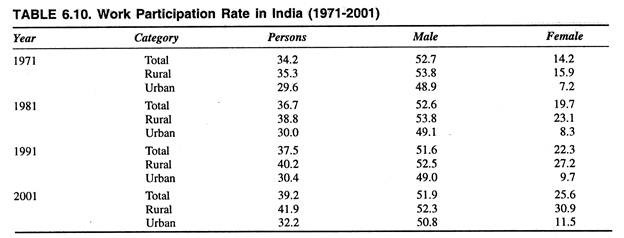In this article we will discuss about the work Force Participation in India. After reading this article you will learn about: 1. Subject Matter of Work Force Participation in India and 2. Workforce Participation Rate in 1991 and 2001 Census.
Subject Matter of Work Force Participation in India:
Labour is considered as a primary factor of production. Labour force is important for maintaining a sound level of economic activity in any country as it is a productive factor and it activates other factors of production for their increasing use in the production system of the country.
Thus the size of labour force existing in a country is playing an important role in determining the level of its economic activity. The size of the labour force is determined by the number of persons in the age group 15-60.
Children’s in the age group of 0-15 years and old people above 60 years are excluded from labour force. In a country, the work force participation rate represented by the proportion of working population to total population depends upon various factors like sex and age composition, attitude and willingness to work, ability to work, job opportunities etc.
ADVERTISEMENTS:
These factors are normally different in different countries and may be different in different periods even in the same country. In India the work force participation rate is now estimated at about 37 per cent as against 45 per cent in England and 50 per cent in Japan. There are some distinctive features of work force in India.
These are:
(1) In India the worker-population ratio is low in comparison to that of developed countries;
(2) In India the rural worker-population ratio is greater than urban worker population ratio as almost all adult members of rural household participate in agricultural activities whereas due to social inhibitions many women in urban areas do not participate in work;
ADVERTISEMENTS:
(3) In India the female worker participation rate is much lower to that of male worker; and
(4) In different states of India, worker participation rates are quite different.
Table 6.9 reveals that the work force participation rate in India had declined from 46 per cent in 1901 to 39 per cent in 1951 and in 2001 the same rate stood at 39.2 per cent. Again the proportion of male workers to total male population gradually declined from 61 per cent in 190 Ho 54 per cent in 1951 and then 52 per cent in 2001.
ADVERTISEMENTS:
But the proportion of female worker to total female population also gradually declined from 32 per cent in 1901 to 23 per cent in 1951 and then to 26 per cent only in 2001. During this period different definitions of work force were adopted in different census and thus these data were not fully comparable.
Workforce Participation Rate in 1991 and 2001 Census:
In 2001 census, the same definition of work force, which was adopted in 1981 census, was also adopted and thus the data became comparable.
Table 6.10 shows the following findings of 2001 Census in connection with the work participation rate:
1. Total work participation rate (WPR) in 2001 has reached the level of 39.2 per cent as against 34.2 per cent in 1971 and 37.5 per cent in 1991.
2. Work participation rate in the urban areas of the country remains almost stable, i.e., around 32 per cent. But the same rate in the rural areas has increased from 35.3 per cent in 1971 to 41.9 per cent in 2001.
3. Work participation rate among the males declined marginally from 52.7 per cent in 1971 to 51.9 per cent in 2001 and that among the females increased from 14.2 per cent in 1971 to 25.6 per cent in 2001. Moreover, the female work participation rate in rural areas has improved significantly from 23.1 per cent in 1981 to 30.9 per cent in 2001 showing an improvement of 7.8 percentage points.
4. A wide variation in work participation rate among the various states of India has been recorded in 1991 ranging from 30.8 per cent in Haryana to 52.2 per cent in Sikkim.
Where a considerable increase in WPR., i.e., at the rate of more than 4 percentage points, has been recorded in Gujarat, Sikkim, Mizoram, Dadra & Nagar Haveli and Daman & Diu, a moderate increase in WPR (from 1 to 3 percentage points) has been recorded in Kerala, Tamil Nadu, Rajasthan, Uttar Pradesh, West Bengal, Pondicherry and Lakshadweep.
ADVERTISEMENTS:
But a very marginal increase in WPR (less than one percentage points) has been recorded in Maharashtra and Bihar.
However, the work participation rate in 2001 census has recorded a considerable change ranging from 32.6 per cent in Uttar Pradesh to 52.7 per cent in Mizoram. High and moderately high WPR is recorded in Sikkim (48.7 per cent), Haryana (39.7 per cent), Orissa (38.8 per cent), Jharkhand (37.6 per cent), Uttaranchal (36.9 per cent), Punjab (37.5 per cent) and Maharashtra (43.4 per cent).
5. Total number of workers in India was 402 million in 2001 and out of which 310 million (77.9 per cent) workers were located in rural areas and the remaining 91 million (22.1 per cent) were located in urban areas.
6. As per the census classification of workers between main workers (working more than 6 months in a year) and marginal workers (working less than 6 months), in 2001 about 313.1 million (77.8 per cent) were main workers and 89.3 million (22.2 per cent) were marginal workers.
ADVERTISEMENTS:
Again out of this total 313.1 million main workers in the country, 127.6 million (40.5 per cent) were cultivators, 107.4 million (34.3 per cent) were agricultural labourers, 16.4 million were household industry workers and remaining 151.0 million (48.2 per cent) were other workers.

